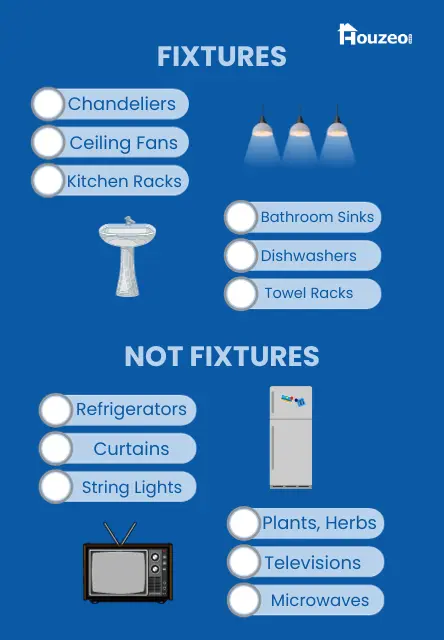✏️ Editor’s Note: Realtor Associations, agents, and MLS’ have started implementing changes related to the NAR’s $418 million settlement. While home-sellers will likely save thousands in commission, compliance and litigation risks have significantly increased for sellers throughout the nation. Learn how NAR’s settlement affects home sellers.
Selling your house can become a source of disagreement with the buyer. Especially when you are figuring out which real estate fixtures you leave in the house.
It is helpful to outline the right fixtures in your sale paperwork. The crucial distinction between real estate fixtures and personal property could sometimes jeopardize your deal in the future.
Fixture-related issues can occur during the final walkthrough. Therefore, to prevent complications and ensure a smooth sale, you should understand the concept of fixtures.
What Are Fixtures in Real Estate?
Real estate fixtures are objects that are permanently attached to the walls, flooring, or roof of your property. They become part of the included assets when you sell the house.
There are ways in which you can understand if an object is a fixture. For example, let’s say your house includes a swimming pool, and you add a cover to it. This cover serves a purpose and, therefore, is a fixture to the property.
Real Property vs. Personal Property
Objects in your house are divided into two categories: Real property and Personal property.
| Criteria | Real Property | Personal Property |
| Assets | All the assets are attached to the house. | All the assets are removable from the house. |
| Ownership | All the assets belong to the property. | All the assets belong to the seller. |
| Legal status | The objects are included in the seller’s agreement. | The objects are not included in the seller’s agreement. |
| Examples | Bathroom sinks, doorbells | Refrigerators, lawnmowers |
What Is the MARIA Test?
The MARIA test helps you determine which fixtures are part of your property. This test is based on different local and state rules. Real estate agents also determine the right fixtures in a property using the MARIA test.
MARIA is an acronym, that stands for the following points:
- Method of Attachment: If an object is attached using bolts, screws, glue, cement, etc. it becomes a fixture to the property.
- Adaptability: Objects adapted in the house for a purpose often become integral to the property. If you attach blinds to your windows, they are integral and, thus qualify as fixtures.
- Relationship: The parties’ relation impacts fixture assessments. In buyer-seller disputes, you typically consider items like blinds as permanent fixtures. However, in landlord-tenant conflicts, you often view tenant-installed items as removable.
- Intention: The purpose decides if an item becomes a fixture. Washers or dryers, not inherently attached, may not default to fixtures. However, if the homeowner intends them as a permanent part, they could be considered fixtures.
- Agreement: The purchase and sale agreement affirms the status of all the objects. Moreover, if the contract specifies that something will stay in the home, it is considered a fixture.
Examples of Real Estate Fixtures

What Are Some Commonly Disputed Fixtures in a House?
Some fixtures are often known to cause trouble while selling your house. You should be aware of some problems that can come if you have such fixtures,
- Lights: Buyers typically consider lights as fixtures since they are attached to the home. If you intend to pack your light fixture when moving, ensure you mention it in the purchase agreement to prevent future conflicts with the buyer.
- Washer/Dryers: These appliances are usually considered personal property. You may determine it as a fixture if they aren’t removable. Add them to the listing agreement if you leave them in the property.
- Window treatments: Curtains and detachable window accessories usually go with the seller. However, people often view curtain rods as fixtures due to their more permanent nature.
- Garden and Lawn: This depends on the agreement with the buyer. However, when grown in unattached pots and vases, people consider the garden as personal property. If grown in the yard, they are a fixture.
Bottom Line
Listing out fixtures in the sale agreement is necessary for a smoother sale of your house. To ensure a successful deal, both the buyer and the seller must align on this topic. This will prevent any negative surprises or disappointments.
Frequently Asked Questions
Are appliances considered personal property?
Appliances like television and washers/dryers are personal property if they are not attached to the house. Appliances that are built in the structure of the house are considered as fixtures.
What are commonly added fixtures in sale contracts?
Most commonly added fixtures in sale listing agreements and are wall mirrors, window treatments and Lights.
Are fixtures the same as fittings?
Fittings are portable items like free-standing furniture and appliances, while fixtures are permanent elements such as integrated appliances, kitchen units, and bathroom suites in a house.
Learn more about real estate fixtures -> What Are Real Estate Fixtures and Why You Should Know About Them?
















